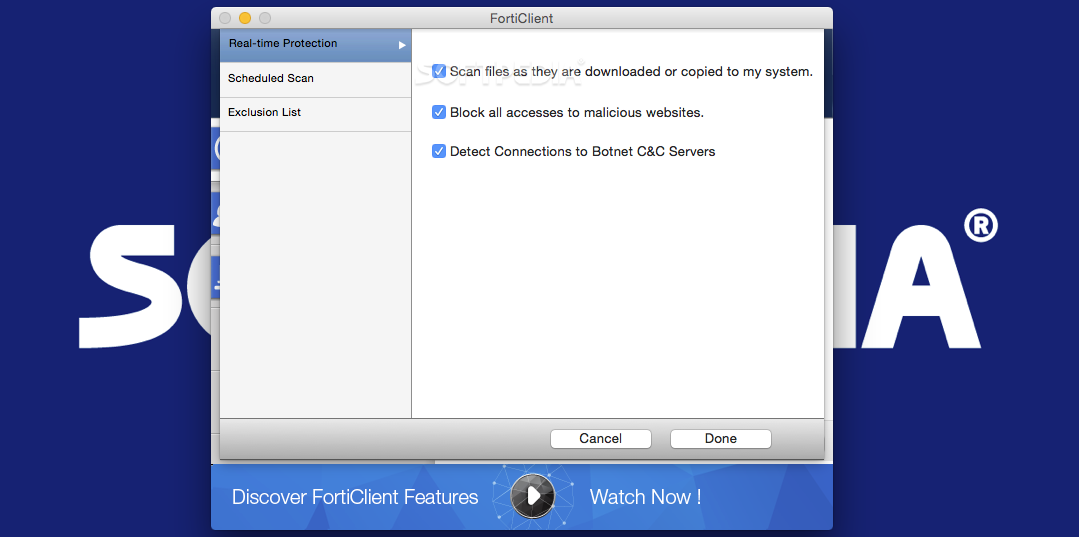Forticlient For Mac
- Forticlient For Mac Sierra
- Forticlient Vpn For Mac
- Forticlient For Mac Big Sur
- Forticlient For Mac
- Forticlient For Mac Os
Fortinet tends to be a little slower resolving MAC related issues with the FortiClient software when compared to Windows etc.guess we can chalk that up to market share. Anyways, roll back your client to an earlier version and see if that resolves the issue for you. Sep 22, 2016 FortiClient5.4.2.523macosx.dmg 2016-11-10 16:11:07 On Mac OS X 10.12, when upgrading FortiClient to 5.4.2, you must use the OnlineInstaller from the FortiClient – FortiClient (Mac OS X) supports Mac OS X v10.12 Sierra. – FortiClient in standalone mode no longer includes a banner at the bottom of the console.
Installing and setting up the FortiClient VPN for Mac clients.
This guide is intended only for students accessing resources while studying from China, if you are located anywhere else in the world or have moved from China then you should follow the standard VPN configuration guides
VPN Registration
You must first register to use the VPN Service, if you haven't already you can register here : VPN Registration
VPN Installation and Configuration
Note: Before beginning, you should ensure your operating system is fully up-to-date with all updates and security fixes as well as the latest anti-virus or malware software.
Forticlient For Mac Sierra
FortiClient VPN 6.4 requires a minimum version of macOS 10.13 (High Sierra), released in 2017, before it will install.
Installation
Download FortiClient VPN
- Once downloaded, click the FortiClientVPNOnlineInstaller (and click Open if asked). The FortiClient VPN install will begin.
- Click Continue then Continue then Agree to the licence confirmation.
- If asked select Install for all users of this computer then Continue.
- Click Install at the bottom right of the window – you might be asked for your macOS password.
- You should see Installation complete. Click Close.
Forticlient Vpn For Mac
Configuration
As China is such a large country we have created two VPN connection points to help improve performance. Which one you should use will depend on where you are located within China but general advice is to connect to the one that is geographically closest:
| Remote Gateway | Region | Area |
|---|---|---|
| 47.112.118.73 | Shenzhen | China South |
| 182.92.210.105 | Beijing | China North |

We recommend that you create two connections in Forticlient VPN and then try both to see which gives the best performance.
- Open FortiClient from either Applications (within Finder), search in the Spotlight box or click the black shield (in the menu at the top of your screen).
- Click Configure VPN in the middle of the FortiClient VPN screen
- For VPN select 'SSL-VPN'
- For Connection Name enter, for example, 'VPN-ED-SSL from China' - Note newer versions many not allow the use of special characters - /:'<>()%@#
- For Description enter 'SSL VPN Connection to UoE from China'
- For Remote Gateway enter '47.112.118.73'
- Tick Customize port and enter 8443
- Leave all other values with their default settings:
- Enable Single Sign ON (SSO) for VPN Tunnel = unticked
- Client Certificate = 'None'
- Authentication = 'Prompt on login'
- Do not Warn Invalid Server Certificate = ticked
- Click Save to save the configuration
Now create a second VPN connection for China North by clicking on the menu to the right of the 'VPN Name' field (3 horizontal lines).

Select 'Add a new connection' from the menu and repeat steps 1 - 7 above but using the following values

- Name VPN@Ed - SSL China North
- Description SSL VPN Connection to UoE from China North
- Remote Gateway 182.92.210.105
Connection
- Launch the FortiClient VPN application if it isn't already running
- Select the VPN connection you have just created from the 'VPN Name' field
- Enter your username(uun) and VPN password (separate from normal password) and click 'Connect'.
Troubleshooting
If you are having problems connecting once you have setup your new VPN connection then check the troubleshooting and common issues page for some suggestions.
A client of mine stumbled across this issue and after some digging it appears to be fairly common. In my experience, FortiClient tends to have more issues with Mac OS in general. For this particular problem though I have had success by rolling back the FortiClient. Downloading the latest from FortiClient tends to be the spot where most people run into issue. Not sure what it is about the older versions that work versus the new one but it is an obvious bug.
If you are sitting around waiting for it to be resolved I wouldn’t get your hopes up. Fortinet tends to be a little slower resolving MAC related issues with the FortiClient software when compared to Windows etc….guess we can chalk that up to market share.
Forticlient For Mac Big Sur
Anyways, roll back your client to an earlier version and see if that resolves the issue for you. I would give you a specific version to roll to but it seems to vary from environment to environment.
Thing To Remember: Sierra is brand new, so the issues, obviously, may not be on the FortiClient side (at least not completely). Worm gear design calculation pdf.
Having trouble configuring your Fortinet hardware or have some questions you need answered? Check Out The Fortinet Guru Youtube Channel! Want someone else to deal with it for you? Get some consulting from Fortinet GURU!
Forticlient For Mac
Forticlient For Mac Os
Don't Forget To visit the YouTube Channel for the latest Fortinet Training Videos and Question / Answer sessions!- FortinetGuru YouTube Channel
- FortiSwitch Training Videos

